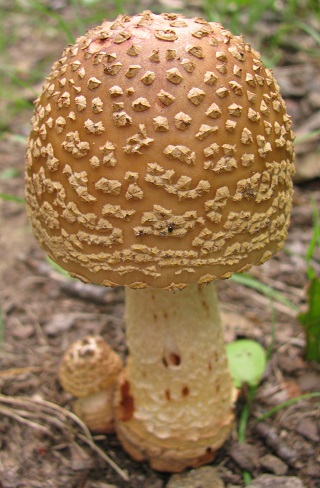Fungi

An Amanita mushroom (Division: Basidiomycota). Amanita mushrooms are poisonous and are common in New England.
Some General Characteristics
Fungi are multicellular or single-celled eukaryotic organisms. They are heterotrophic, although some taxa contain autotrophic symbionts. Most fungi have cell walls during at least one stage of their life cycle. A substance known as chitin forms an important and characteristic component of their cell walls. Other information useful for understanding fungi is summarized below.
Two growth forms are found in fungi: filamentous and yeast. Filamentous fungi consist of tubular elongated filaments, known as hyphae, while yeasts occur as round, nearly spherical, solitary cells. Some fungi are able to switch between these two forms.
Fungi feed on organic matter by secreting enzymes into the environment. The enzymes break down the food, releasing nutrients that the fungi are then able to absorb. Fungi grow into their food as they consume it. Many or most fungi are considered to be saprobes— they feed on dead organic matter. Some fungi are parasitic, some are predatory (they trap or otherwise immobilize prey before feeding on them), and others obtain at least some of their nutrients (organic carbon and in some cases nitrogen) from symbiotic associations with photosynthetic organisms.
Fungi are a challenging group of organisms to identify and classify. They are morphologically simple, so there are relatively few characteristics that can be used to identify them. Many of these characteristics apply to their sexual structures, which in some cases may be rarely or never observed.
In some fungi, the asexual form (called an anamorph) looks very different from the sexual form (called the teleomorph). Unfortunately in many instances this has resulted in a single species of fungus being assigned more than one scientific name— one name for the anamorph (or for each of the anamorphs if there are more than one) and a different name for the teleomorph. In many cases this problem of "dual nomenclature" arose inadvertently— because people didn't realize they were giving different names to the same species. In other cases, scientists deliberately assigned different names to anamorphs and teleomorphs of the same taxon— perhaps as a means of providing crucial information about a fungus (e.g., only one form may produce toxins) (Pitt and Samson 2007), or because of the close resemblance of an anamorph to anamorphs of other species (Raven et al. 1992). The International Botanical Congress, which formerly permitted a system of dual nomenclature for fungi, adopted a resolution to end the practice in 2011 (Hawksworth 2012). Now the accepted practice is "one name for one fungus". As a consequence of this change, scientists now need to reassess perhaps as many as 12,000 scientific names (Hawksworth 2012).
Groups of Fungi
Fungi can be separated into two groups depending on whether they produce a dikaryon at some point during their life cycle. A dikaryon or dikaryotic hypha contains two different but compatible nuclei within each cell or septum-separated compartment. The fungi that produce cells with these paired but unfused nuclei— the dikaryotic fungi— comprise two divisions: the Ascomycota and the Basidiomycota. These two groups are sometimes referred to as the "higher fungi." Other fungi, which are not known to produce dikaryons, are called monokaryotic fungi because their nuclei always occur singly— either one nucleus per cell, or if the cell is multinucleate, the nuclei are never paired.
Groups of fungi are listed below. Fungi that form lichens (symbiotic associations with algae and/or cyanobacteria) are shown separately below because lichens are usually studied together as a group. However, the lichen-forming fungi do not form a clade— they just all have adaptations that allow them to form these symbioses. The great majority of lichen-forming fungi belong to the Ascomycota, a relatively small number belong to the Basidiomycota.
- Monokaryotic Fungi
- Chytridomycota
- Cryptomycota
- Zygomycota
- Dikaryotic Fungi
- Lichens (Dikaryotic fungi in symbiosis with algae and/or cyanobacteria)
Sources
Choi, J. and S. Kim, 2017. A genome tree of life for the fungi kingdom. PNAS, 114(35): 9391-9396.
Hawksworth, 2012. Managing and coping with names of pleomorphic fungi in a period of transition. IMA FUNGUS, 3(1):15-24.
Herskowitz, I. 1988. Life cycle of the budding yeast Saccharomyces cerevisiae. Microbiological Review, 52(4):536-553.
Pitt, J.I. and R.A. Samson, 2007. Nomenclatural considerations in naming species of Aspergillus and its teleomorphs. Studies in Mycology, 59:67-70.
Raven, P.H., R.F. Evert, and S.E. Eichhorn. 1992. Biology of Plants. Fifth edition. Worth Publishers: New York. 791 pages.
Last edited: 21 Jan. 2018
